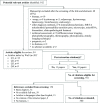Post retraction citations among manuscripts reporting a radiology-imaging diagnostic method
- PMID: 31194762
- PMCID: PMC6563977
- DOI: 10.1371/journal.pone.0217918
Post retraction citations among manuscripts reporting a radiology-imaging diagnostic method
Abstract
Our study aimed to evaluate the trends of post retraction citations of articles reporting a radiology-imaging diagnostic method and to find if a different pattern exists between manuscripts reporting an ultrasound method and those reporting other radiology diagnostic methods. This study reviewed retractions stored in PubMed on the subject of radiology-imaging diagnosis to identify the motivation, time from publication to retraction, and citations before and after retraction. The PubMed database was searched on June 2017 to retrieve the retracted articles, and the Scopus database was screened to identify the post-retraction citations. The full text was screened to see the type of post-retraction citation (positive/negative) and whether the cited article appears or not as retracted. One hundred and two retractions were identified, representing 3.5% of the retracted articles indexed by PubMed, out of which 54 were included in the analysis. Half of the articles were retracted in the first 24 months after publication, and the number of post retraction citations was higher than the number of citations before retraction in 30 out of 54 cases (US methods: 9/20, other diagnostic methods 21/34, P-value = 0.2312). The plagiarism was the most common reason for retraction (31%), followed by repetitive publication (26%), and errors in data/manuscript (24%). In less than 2% of cases, the retracted articles appear as retracted in the text or reference list, while the negative citation is observed in 4.84% among manuscripts reporting an US diagnostic method and 0.32% among manuscripts reporting a diagnostic method other than US (P-value = 0.0004). No significant differences were observed when post retraction weighted citation index (WCI, no. of citations weighted by citation window) was compared to WCI prior retraction (P-value = 0.5972). In light of the reported results, we enumerated some recommendations that could potentially minimize the referral to retracted studies as valid.
Conflict of interest statement
The authors have declared that no competing interests exist.
Figures




References
-
- Wager E, Barbour V, Yentis S, Kleinert S, on behalf of COPE Council. Retraction Guidelines. Available from: https://publicationethics.org/files/retraction%20guidelines_0.pdf (accessed January 25, 2018). 10.3325/cmj.2009.50.532 - DOI
MeSH terms
LinkOut - more resources
Full Text Sources

